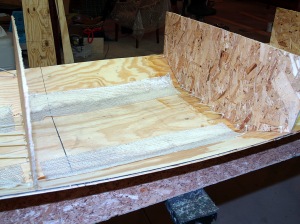Earlier this week, I “tack welded” the edges between the bottom and the lower chine pieces. The idea is to get enough epoxy in place to hold the parts together without the aid of the plastic tie wraps. Because of the large clearances between the parts, the epoxy has to be thickened with sawdust (or to use the term on the side of the bag, “wood flour”) to keep it from just seeping through the gaps and adding to the already copious amounts currently adhered to my basement floor. It has to be thin enough to get down in the tighter gaps (what few there are), though, so it would still drip through and cause difficult to remove stalactites on the outside of the boat. To avoid that, I ran masking tape along the outside seams where ever I could see light coming through.
The epoxy/wood flour slurry also has to be thin enough to be loaded into the applicator, which in this case is a plastic hypodermic syringe:

I mixed the slurry in a plastic drink cup, and sucked it up into the applicator by sticking the open end into the mix and drawing it in by pulling out on the plunger. I then filled the gaps between the parts by injecting the epoxy mix into them:

Where the gaps were really, really wide, I trimmed some thin shims of plywood from some of the scrap left over from cutting out the larger pieces and stuffed them into the gaps before injecting the slurry:

I let the epoxy set up for a few days, mostly since the latter half of the week was pretty hectic and I never really had the time and/or energy to start on the next part. Today’s weather being what it is (read: crappy), I moved on to filleting the seams and covering them with fiberglass cloth tape. The tape doesn’t handle sharp angles well, and the fillets aid in that by providing a larger radius for the tape to work with. I suspect that the fillets also provide a bit more strength to the joints, but their primary purpose is to provide a good seat for the joining tape.
The epoxy gets mixed with wood flour again, but this time to a consistency almost like that of modeling clay. It is going to be pushed down into the seam and molded into the required shape, so there is no reason to it to be very thin. That consistency precludes the use of the syringe for getting it into the boat, though, so I used a different technique. With the filleting, I use a plastic kitchen storage bag with a tip cut into one of the corners, much the same way a bag would be used to apply decorative icing to a cake.
The first step is one of those that requires a pretty healthy dose of faith: cutting the tie wraps out. The faith comes in believing that the tack welds will hold and the whole boat won’t explode apart:

It held together, so I went ahead and cut the pieces of fiberglass tape to length:


This is one of the costs of using the OSB molds to hold the parts together. If I was just using spreaders, I would be able to do each side all at once. With the molds in the way, I have to work in the bays, and when the molds come out, I will have to go back and fill in the gaps. It’s a small trade-off, in my opinion, given the huge benefit the molds provide in the initial shaping of the boat.
With the epoxy mixed and squeezed down to the corner of the bag, someone needs to help by cutting the corner. I have an itinerant laborer that comes down to the Boat Works now and then to lend a hand:

It’s easy to then simply run a line of the thickened epoxy down along the seam:


When I did this with the kayak, I then used the end of a plastic spoon to impress the fillet shape into the epoxy. This time I just laid the glass into it and pressed it down into shape with a gloved finger:

I then mixed up a batch of unthinned epoxy to wet out the tape. This remains a job that I’d prefer to be able to hand off to Mike Rowe. The loosely woven fiberglass tape sheds threads easily, and they get strung along with the plastic spreader that I used to move the epoxy around. If I leave them there, I have to try to sand or scrape them away later. This being a canoe, there’s not even the opportunity to hide away the majority of my sloppy work like there was when doing the interior of the kayak. I got it done, but between the glass and the wood being very thirsty, I’m already starting to wonder if I will have enough of the relatively expensive epoxy to finish the job:

Mid-way through the wetting out, my laborer complained about the atrocious smell and left the Boat Works. I haven’t yet decided if it was the smell of the epoxy or that of the Chief Boat Builder, who had at the time not yet showered, that she was complaining about, and she won’t say. Smart girl, that one!
Read Full Post »





















